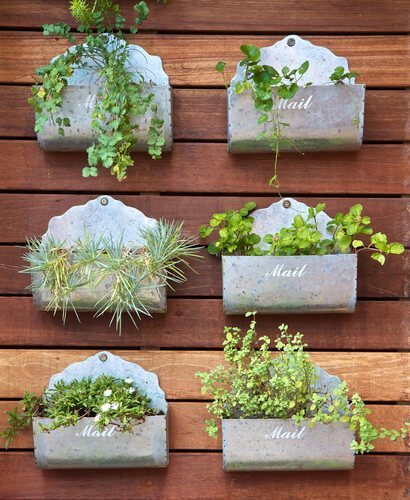Apart from being a spectacular feature in any home, vertical gardening is an easy and practical way to make use of space in small modern homes. Vertical gardening means your plants can get all the sun they need while taking up a minimum amount of space in your yard, on your balcony or even in the kitchen. For the best results when planning a vertical garden, consider these simple tips to make your garden pop.
1. Create a great shape
When deciding on the shape of the structure, consider the wall space, air space and ground space you can reasonably cover while keeping the plants in a sunned area. The structure may take on a pyramid shape or lay flat against the wall.
For a wall mounted vertical garden, use sheet metal to create interesting feature designs.
2. Use the right material
If planting your vertical garden in an area that’s fully exposed to the elements, avoid using materials like wood that can become weak and chip away, taking the garden with it. Opt for durable materials like high grade sheet metal.
3. Put it on wheels
Do you want your vertical garden structure to be mobile? Mobility (i.e. attaching wheels to the structure) means you can move it around to catch sunlight at different time of year and you’re free to take it with you when you move house.
4. Control your shade
Consider the order of the plants in your garden. Place lower light plants at the base of the vertical garden in case plants higher on the structure grow oversize and shade the lower ones. This way you can ensure that your garden continues to grow all the way up!
5. Ensure easy access
Make sure you will have access to any plants that need pruning or harvesting BEFORE you attach your vertical garden structure to a wall or fence. Alternatively, fix the structure to a piece of sheet metal which can be attached to the wall or fence by hinges, runner or rollers for easy access to your plants.
6. Make smart plant choices
Be very aware of the plants you choose for your vertical garden, particularly in regards to how much sunlight they need and how much they will grow (individually) to prevent them from over shading each other.
Try to keep each garden within a plant group, e.g. all herbs or all climbing vines. Mixing and matching can cause problems when it comes to watering, feeding and placement for sunlight.
7. Swap out your soil
The soil for plants that consume a lot of nutrients, such as herbs and vegetables, needs replacing regularly. Make sure the soil you use is suitable for all the plants in your garden.
8. Never forget fertilisation
Fertilise your garden as required. It’s best to consult a professional at your local gardening store to know how frequently each type of plant needs fertilising. Fertilising can ensure a strong vertical garden and an impressive before and after shot.
9. Maintenance
Be sure to get rid of dead plants and excess leaf matter as it drops. Too much organic matter in the garden can cause mould and unwanted fungi to spring up and compete with your plants for nutrients.
10. Keep at it!
Be aware that while your vertical garden might start out looking like this; it won’t be long before it ends up looking more like this!
Start planning your vertical garden DIY project today. Contact Queensland Sheet Metal for advice on how to start work on your project using sheet metal as a base.


